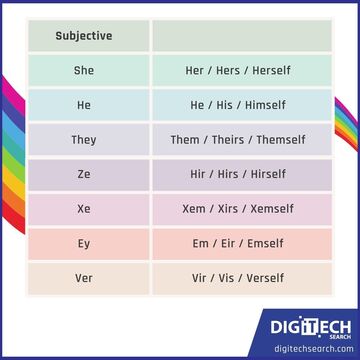What are gender-neutral pronouns and how should they be used?
Adopting diversity, equality, and inclusion (DE&I) has become crucial to fostering a flourishing and forward-thinking society in today's world of rapid change. About 46% of job seekers cite company culture as very important when choosing to apply to a company (source: Jobvite). So, a basic commitment to recognising the individuality and value that each person brings to the table, regardless of their history, identity or opinions, embracing DE&I is more than just a catchphrase or a box to tick.
When first meeting someone, most people agree it’s best not to outright ask for pronouns because someone may feel like you’re assuming their gender identity. In some cases, it may put someone in a situation where they have to out themselves but don’t want to or aren’t ready to.

In English, "He" is often used as an automatic fill-in for generic individuals.
"He" and "she" are also two extreme binaries that don't leave room for other gender identities, which can be hurtful for transgender, nonbinary and genderqueer communities.
Ultimately, you probably don’t want to make incorrect or hurtful assumptions about someone’s gender — they could be agender, nonbinary, or uncomfortable identifying with “he” or “she”.
So here we list some common gender-neutral pronouns and how to use them.
‘They’ is one of the more common gender-neutral pronouns and it's easy to incorporate into your daily conversations. For example:
- I spoke to the marketing director, and they said they’d get back to me.
- Who oversees that campaign? I will email them.
‘Ze’, ‘Hir’ and ‘hirs’ are gender-neutral pronouns used to refer to individuals who identify outside the traditional binary gender system. Here are some examples of how to use them.
- Ze is going to the store.
- I gave the book to hir.
‘Xe’. ‘Xem’, ‘Xirs’ and ‘Xemself’ are also gender-neutral pronouns that are gaining recognition and usage among people who identify as non-binary, genderqueer or otherwise gender non-conforming. Here is an example of how they are used:
- Xe is going to the company party.
- I Invited Xem to join our video calls.
‘Ey’, ‘Em’ and ‘Eir’ are gender-neutral pronouns and are part of the ever-expanding set of gender-inclusive language options. Here is how they can be used:
- Ey is going to Germany for the tech conference.
- I met em at the café downstairs.
‘Ver’. ‘Vir’ and ‘Vis’ are a set of gender-neutral pronouns that are used by some individuals who identify outside the traditional gender binary. Here are some example:
- Ver is interviewing a candidate I recommended.
- I saw vir at the tech tradeshow in Germany.
Here are just a few of the most common pronouns we use, but as language continues to evolve, it's important to keep learning and adapting to create a more respectful and understanding community for everyone.
Gender-inclusive language and pronoun options are essential in promoting a more inclusive and welcoming office environment, where individuals of all gender identities feel recognised and accepted. It is okay to make a mistake and this holds true for pronouns. The best thing to do is acknowledge it immediately and move on. Embrace making mistakes and commit to learn from them.
Reference: Jobvite / Hubspot


Comments
Be The First To Post